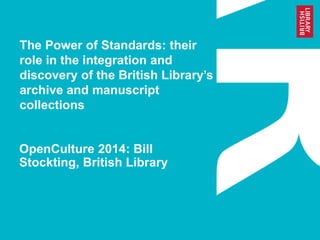Open culture2014 power_eadv2
- 1. The Power of Standards: their role in the integration and discovery of the British LibraryŌĆÖs archive and manuscript collections OpenCulture 2014: Bill Stockting, British Library
- 2. www.bl.uk Introduction ŌĆó Briefly describe collections ŌĆó The situation in 2007 ŌĆó The 6 Step Programme detailing information standards used ŌĆó Conclude by noting how standards used are enabling us to provide greater online access to the collections
- 3. www.bl.uk Archive and Manuscript Collections Papyri to the papers of living authors: ŌĆó Manuscripts: Asian, Literary, Music and Western including archives of creatives ŌĆó Records of East India Company and its successors, and related private papers ŌĆó Digital collections, e.g. Endangered Archive Programme ŌĆó Now also Visual Arts collections
- 4. www.bl.uk 2007: The problem Mission: To deliver a powerful, flexible integrated cataloguing and resource discovery system that will unite and broaden access to the British LibraryŌĆÖs archives and manuscript collection and will provide standards compliant data for external co-operative projects 100ŌĆÖs of separate catalogues ŌĆó Big and small ŌĆó Managed by many people across the Library ŌĆó Some online, some only available in reading rooms, some only for curatorial access ŌĆó Many different formats: databases, excel, WORD and HTML ŌĆó Various description standards and none
- 5. www.bl.uk Step 1: Procure a Standards Based Catalogue System An in-house development ŌĆō Integrated Archives and Manuscripts System or IAMS: ŌĆó Data model based on the ICA Standards for Archival Description especially: ŌĆō ISAD(G) ŌĆō archival aggregations ŌĆō ISAAR(CPF) ŌĆō creating and subject entities ŌĆó In-house content standards based on national and international practice but also external vocabulary standards to ensure data is interoperable, eg: ŌĆō Languages: ISO 639-2 etc ŌĆō Scripts: ISO 15924
- 6. www.bl.uk Step 2. Migrate Legacy Data ŌĆó Since 2009, over 2 million legacy records migrated to the system ŌĆó In principle did as little manual work as possible ŌĆó Took opportunity though to programmatically amend data: ŌĆō To provide structure demanded by our descriptive standards ŌĆō To normalise key elements: languages, scripts, dates etc
- 7. www.bl.uk Step 3. Develop Persistent Identification ŌĆó Mass digitisation now happening, egs: ŌĆō Gulf History Portal ŌĆō Europeana WW1 ŌĆó IAMS integrated into the LibraryŌĆÖs digital infrastructure ŌĆó Complex but key glue for this is Persistent Identification for catalogue records as well as content using ARK standard
- 8. www.bl.uk Step 4. Clarify Rights and Licensing ŌĆó Rights and licensing part of content publication process but also that for metadata ŌĆó Ascertained that we have the rights to the metadata ŌĆó Library makes BNB available as Linked Open Data as CC0 so IAMS data declared as such too
- 9. www.bl.uk Step 5. Share Metadata Promiscuously ŌĆó Finally we are in a position to share our metadata with anyone that wants itŌĆ” ŌĆó Standards here for allowing access: ŌĆō Web services ŌĆō RESTful API ŌĆō OAI-PMH Repository ŌĆó XML data in many formats: ŌĆō EAD, EAC-CPF ŌĆō TEI, VRA Core ŌĆō MARCXML, Dublin Core ŌĆō MODS wrapped in METS ŌĆō RDF...
- 10. www.bl.uk Step 6. Get Involved in Standards Development ŌĆó Library now involved in standards development, promotion and use for archives: ŌĆó UK: ŌĆō Descriptive Standards Roundtable ŌĆō UK Archives Discovery Network ŌĆó International: ŌĆō Society of American ArchivistsŌĆÖ - EAD ŌĆō ICAŌĆÖs EGAD ŌĆō Conceptual Model for Archives
- 11. www.bl.uk
- 12. www.bl.uk
- 13. www.bl.uk
- 14. www.bl.uk
- 15. www.bl.uk
- 16. www.bl.uk
- 17. www.bl.uk


















